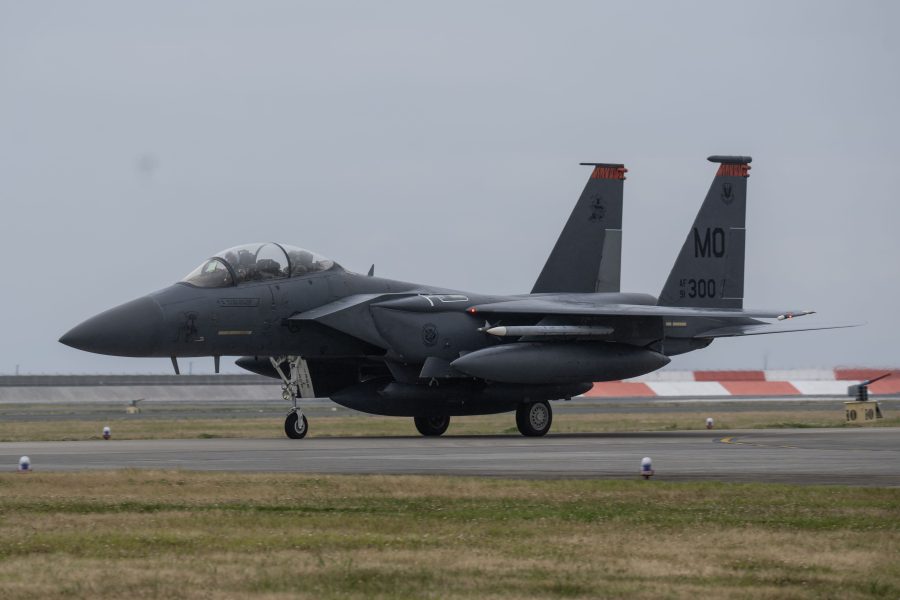The Senate will start debate on the 2024 National Defense Authorization Act on July 18, as lawmakers wade through 666 amendments proposed amendments filed to the bill.
The proposals cover everything from the Department of State’s authorization bill to a prohibition on slaughtering horses for human consumption; many have little or no relation to defense policy. Senators vie to attach legislation to the NDAA because it’s “must-pass” legislation. Over the course of debate, most proposed amendments will be dropped. Some may be packaged together for quick, uncontroversial votes. And some will receive their own debates and roll-call votes.
The House has already passed its version of the authorization bill, and once both chambers have passed a bill, the two must be reconciled. But first, the Senate must have its day.
For the Air Force, several of the amendments could have lasting repercussions for the service.
Fighters
The Air Force quietly revealed plans earlier this year to cut its F-15E fleet to 99 aircraft in the coming years—a reduction of more 119 aircraft. Air Force Chief of Staff Gen. Charles Q. Brown Jr. was asked about the cuts in his confirmation hearing to become the next Chairman of the Joint Chiefs, answering that the cut was necessary to “balance capability and capacity.”
Sen. Ted Budd (R-N.C.), who raised the issue with Brown on July 11, represents Seymour Johnson Air Force Base, one of five bases with F-15Es, and offered an amendment the next day that that would prohibit F-15E retirements through fiscal 2029.
Budd’s drive to save the F-15E comes as other lawmakers press to increase procurement of the new F-15EXs variant. USAF asked for 24 F-15EXs in 2024—restoring some planned purchases that had been cut a year earlier. Air Force Secretary Frank Kendall said the service would go no further, but that hasn’t stopped some legislators.
Rep. Mike Rogers (R-Ala.), chairman of the House Armed Services Committee, added funds to his markup of the NDAA for advance procurement of six extra F-15EXs in 2025, and an amendment from Rep. John James (R-Mich.) adopted by the House added funds to buy two more EXs in 2024.
Another amendment included in the House bill from Rep. Don Bacon (R-Neb.) would prohibit the Air Force from terminating the flying mission of any Guard fighter squadron until at least 180 days after USAF submits a “notional plan” on how it will recapitalize every Guard fighter squadron. Sen. Mike Crapo (R-Idaho) introduced a matching amendment in the Senate.
Bombers
Sen. Ted Cruz (R-Texas) filed a series of amendments touching on the Air Force’s bomber fleet—unsurprising given that he represents Dyess Air Force Base, which hosts the B-1B Lancer.
- One would extend a previous prohibition on modifying “the designed operational capability statement for any B–1 bomber aircraft squadron … in a manner that would reduce the capabilities of such a squadron below the levels specified in such statement” until the B-21 Raider starts to be fielded.
- Another amendment would provide $30 million to test hypersonic weapons on the B-1—a possibility the Air Force has been studying with the development of a new pylon by contractor Boeing that enables the long-range bomber to carry such weapons.
- Finally, Cruz also wants to take $45 million out of the B-21’s research, development, test, and evaluation account and redirect it to fund military construction to support B-21 basing at Dyess.
Other Aircraft
A number of other Air Force fleets would be protected under amendments filed in the Senate.
- Sen. Dick Durbin (D-Ill.) wants to once again prohibit any divestment of the C-40 Clipper, used to transport senior military commanders, Cabinet officials, and members of Congress.
- Sen. Amy Klobuchar (D-Minn.) wants to extend a requirement that the Air Force to maintain a fleet of at least 271 C-130s through 2024.
- Sen. James Lankford (R-Okla.) introduced an amendment that would prohibit the Air Force from reducing its E-3 AWACS fleet to less than 16 aircraft until the service submits a plan “for maintaining readiness and ensuring there is no lapse in mission capabilities,” or until it starts buying the E-7 Wedgetail.
Next Steps
The House passed its version of the NDAA on July 14, largely along party lines after Republicans included amendments on a host of contentious issues that would cut funding for diversity, equity, and inclusion programs and out-of-state travel for reproductive health care, and more.
Some lawmakers introduced corresponding amendments in the Senate, but they are unlikely to succeed in the Democratic-controlled chamber. If and when the Senate does pass the larger bill, a conference committee will be appointed to resolve differences between the House and Senate versions, and send that combined measure back to both bodies for a vote.
